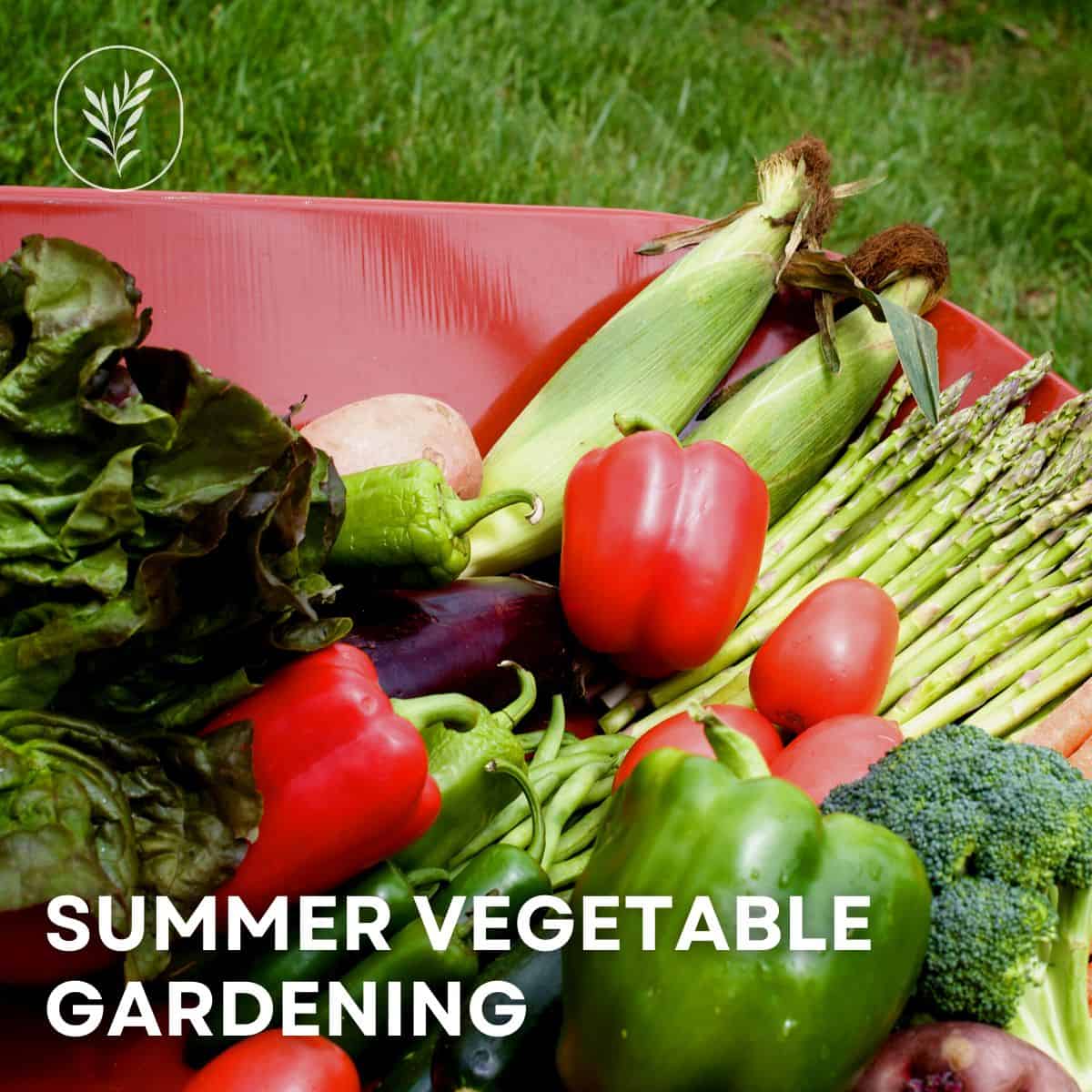Summer vegetable gardening can bring an abundant harvest, along with dry soil and hot temperatures. Here are 10 top tips for keeping your vegetable garden healthy in the heat of summer.

1. Pick and preserve
Summer vegetable crops like cucumbers, green beans, runner beans, zucchini, beets, carrots, onions, shallots, potatoes, and salad greens can all be ready to harvest during the summer. If you’ve grown more than you can eat right now, it’s time to preserve the harvest for the cooler months. Have a canning party, make fridge pickles, start fermenting, fill up the freezer, or make smoothie cubes. Don’t let your hard work thus far go to waste!

2. Water, water, water
Slow and steady watering is the key to successful summer vegetable gardening. Most vegetable crops perform their best with a consistent, steady supply of water. Make daily trips to the veggie patch to ensure everything has enough moisture available. Consider installing drip irrigation.
A smooth, steady supply of water will discourage crops like spinach, dill, and cilantro from bolting too quickly. It can also help keep fruiting crops like tomatoes from cracking. Cracks in tomatoes often result from the plant rapidly taking up too much water after a period of drought. Keep the water consistent! An adequate layer of organic mulch like straw or compost can help keep soil moisture steady.
“Continue watering during dry spells. Avoid letting plants wilt to show you they need water – pay attention to soil moisture and rainfall (or lack thereof) to know when it’s time to give your gardens a drink.”
Rodale’s Basic Organic Gardening: A Beginner’s Guide to Starting a Healthy Garden, by Deborah L. Martin

3. Sow fall crops
Yes, you can still plant seeds as part of summer vegetable gardening! Crops with short growing seasons can be planted in the summer for a fall harvest.
Salad crops like arugula and lettuce are great candidates. So are short-season beans and peas. You can also consider planting overwintering crops in midsummer (generally brassicas like cabbage, brussels sprouts, broccoli, and/or kale).
4. Thin out large vegetable crops
If you’re trying to grow great big pumpkins for Halloween or an extra-heavy tomato for the fall fair, now is the time to thin out the fruit. Pumpkins and squash grown to be large are generally thinned down to one fruit per plant. This allows the vine to put all its energy into one prize-winning big pumpkin!

5. Apply organic fertilizer
Summer vegetable gardening generally includes at least one feeding for most crops (particularly tomatoes, peppers, and pumpkins). Use a slow-release, granular organic fertilizer and apply according to the package directions. This will give the plants a gentle boost without subjecting them to a synthetic fertilizer jolt.
“Nitrogen is often the difference between a booming garden and one that’s gasping for air. It is responsible for rapid plant growth and the green colour of leaves and shoots.”
Building Soil: A Down-to-Earth Approach: Natural Solutions for Better Gardens & Yards, by Elizabeth Murphy

6. Enjoy edible flowers
Summer is the perfect time to add a few edible flowers to your garden-to-table meals. Zucchini plants can contribute a few extra flowers to the grill, and herbs like nasturtium can add an unexpected zip to a salad.
7. Fill up the spice rack
Now is a great time to dry any herbs and spices from your garden and store them for year-long use. Dry some oregano for your tomato sauce and some dill for winter fish dishes. Harvest some rosemary and freeze some chives. You’ll be glad you did when the ground is blanketed in snow, but you’re enjoying the flavors of your garden from the warmth indoors.

8. Help the heavy hitters
Crops with heavy yields may need some support as summer goes on. The leaves can get a little sun-scorched at the same time that the fruits start to get heavy and ripe. The plants might need a little support!
This is particularly true for vining crops like indeterminate tomatoes, melons, and cucumbers. Tie them to sturdy trellises, stakes, or other support structures to take some of the weight of the fruits off of the vine.
You may also wish to stake your pepper plants, even though they aren’t vines. A single stake or small tomato cage can help hold the fruit up as it gets heavy. And don’t forget to save the seeds from the first few peppers!
9. Get that compost cooking
Summer brings hot temperatures and hot temperatures speed up decomposition. Keep the compost pile moist and turn it often to introduce air into the mix. It can be helpful to get a finished batch out of the compost area before the onslaught of autumn leaves starts to arrive.

10. Take it all in
The veggie garden is in full bloom! Take some time to revel in the season. Summer vegetable gardening isn’t all about work!
Take photos of your vegetable plants. Sit in the shade with your own homemade cucumber mint water. Eat the first homegrown heirloom tomato in the garden while it’s still warm from the sun. Make a mental memory of the bounty of the summer garden to remember during those dreary days of winter. You’ll be glad you did!










